Part
6 : Seaside Photography - The Picture Postcard
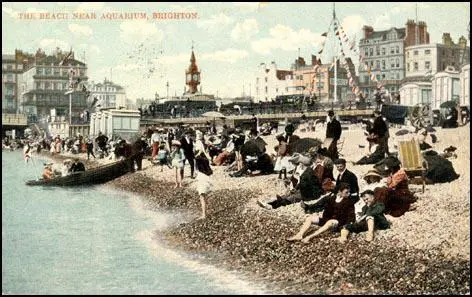
1. Picture postcard of Brighton
Beach near the Aquarium. Post-marked 1st March 1909, this coloured
card was produced by the firm of Max Ettlinger & Co. Ltd of
London & New York
The
Origins of the Official Post Card
In
1865, at the Austro-German Postal Conference held in Karlsruhe,
Germany, Dr. Heinrich von Stephen put forward the idea
of an "open post sheet" made of stiff paper or thin
card, which could be used as a cheap form of written communication.
However, Dr Stephen's idea of an officially produced postcard
was not adopted.
In January 1869, Dr. Emmanual Hermann of Vienna, a professor
of economics, revived the idea of producing printed postcards
and on 1st October 1869, the Austrian Post Office issued
the world's first official postcard. The postcard was a great,
popular success and around 2 1/4 million
postcards were sold in the first three months.
Other
postal authorities in Europe followed the Austo-German example.
On 26th May 1870, the British Postmaster-General recommended the
production of "Correspondence Cards" and on 1st October
1870, the first official postcards in Britain were issued
by the Post Office. These early postcards were printed by the
famous firm of De La Rue and incorporated a printed, stamp. The
officially produced Post Card carried a prepaid stamp to the value
of 1/2 d, a new postal rate for open correspondence.
The postal rate for letters in a sealed envelope remained at one
penny. At half the standard postal rate, the Post Card was immediately
popular, and 675,000 were sold on the first day of issue.
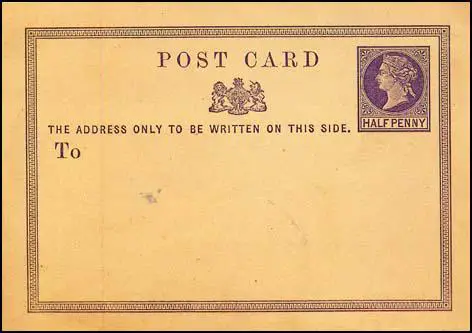
2 Britain's first Official
Post Card with a printed stamp.( 1870).Up until 1894 only official
pre-paid postcards could be sent in the post.
Illustrated
Post Cards
No
pictures were allowed on the early official Post Card, but from
1872, private firms were allowed to print postcards which carried
advertisements, as long as these commercial cards bore the official
pre-paid stamp. Around this time, postcards were produced that
featured line drawings. An early example carried line illustrations
of London landmarks such as St Paul's Cathedral and London Bridge.
The
production of pictorial cards was inhibited by the restrictions
imposed by the Post Office rule that post cards had to carry a
printed prepaid stamp. A major breakthrough occurred when the
British Post Office announced that from 1st September 1894,
privately printed post cards could be sent through the post with
an adhesive halfpenny stamp. Publishers could now offer for sale
picture postcards which could be sent through the post at the
cheap postal rate. Within the month, postcards featuring pictures
of local views were sent in the post. A picture postcard of Scarborough
has been found which carried a postmark date of 15th September
1894. This early pictorial view card was produced by the postcard
publisher E.T.W.Dennis of Scarborough. Other publishers
that produced local view postcards in 1894 include George Stewart
& Co of Edinburgh and F.T.Corkett, a firm based
in Leicester.
These
early pictorial view postcards did not carry actual photographs.
The views on the earliest picture postcards were engraved from
line drawings and could not cover the whole side of the card as
postal regulations stipulated that the front of the postcard,
which carried the stamp, was reserved for the address only. The
message had to be written on the reverse side and therefore had
to share space with any pictorial illustration. These early commercial
produced 'local view' cards provided an illustration to go alongside
the written message or provided a decorative border around the
space that was reserved for the greeting or message.
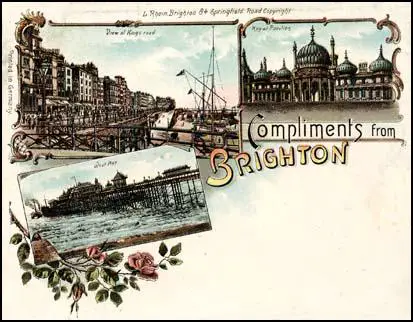
3.
An early coloured court-size postcard from Brighton.
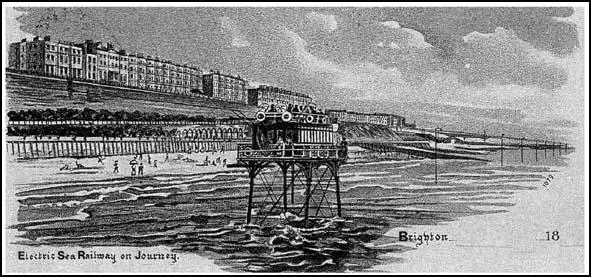
4. An
engraved drawing of Volk's Seashore Electric Railway in Brighton,
which appeared as an illustraton on the message side of an early
pictorial postcard. The Electric Sea Railway ran from Kemp Town,
Brighton to nearby Rottingdean.This
design was Published in 1899 by the Pictorial Stationery Company
Ltd of London.
arly Court
Photographic
Postcards
Although
many of the early illustrations were derived from line drawings,
a number of early picture postcards employed images that were
taken from photographs. For example, in 1894, Walter Gardiner,
a photographer with a studio in Worthing, Sussex, designed a pictorlal
postcard which incorporated views of Worthing beach and a local
park taken from his oriiginal photographs of the scenes.
The
photographic images that were featured on postcards in the 1890s
were not actual photographs, but pictures that had been reproduced
using the pictorial printing processes of the day - lithography,
photogravure, half tone photo-engraving and other photomechanical
techniques.
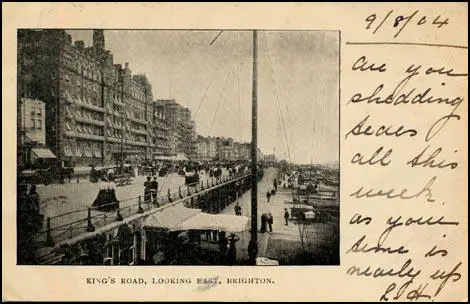
5.
Picture postcard of Brighton's King's Road, looking east. This
postcard carries a mechanically produced photograph rather than
a real photograph and was mass produced. The message has been
written alongside the picture and is dated 9th August 1904. The
reverse of the card carries a half penny stamp which has been
post-marked " BRIGHTON : 6.30 pm .August 9 1904.The card
was addressed to a Miss Chase in South East London.
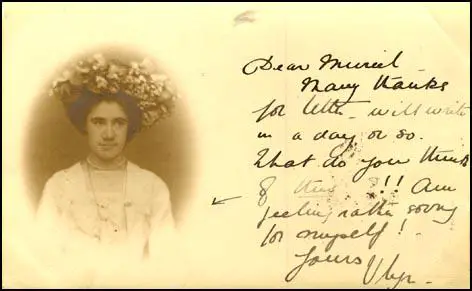
6.
This portrait was taken at the American Art Rapid Photography
studio on Brighton's Palace Pier in 1902 and turned into a personalised
postcard. Postal regulations meant that the message had to be
written on the image side. The other side of the card carried
the address of a Miss M. Goodwin of Kidderminster and is post-marked
"BRIGHTON : September 7, 1902".
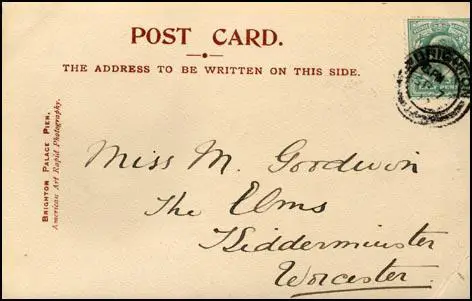
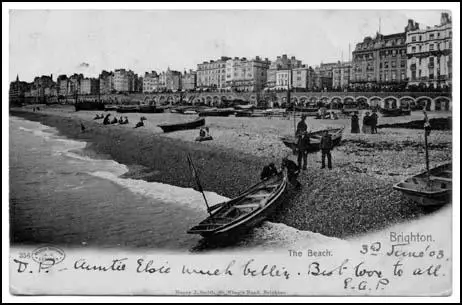
7.
A postcard featuring a printed photograph dated 30 June 1903.
CLICK HERE TO CONTINUE
Origins of the Official Post Card